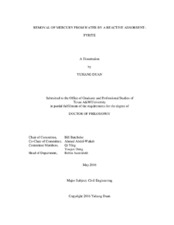| dc.description.abstract | Pyrite has been demonstrated to be an excellent absorbent in removing mercury in many studies. Most of them used natural pyrites that were ground to micro-scale size or even larger. This study investigated methods to produce nano-scale pyrite particles. FeCl3 and NaSH were used as the source chemicals to synthesize pyrite. Several aging methods, including hydrothermal, ultrasonic and microwave irradiation, were studied in order to reduce the particle size. Surface analysis showed that microwave irradiation was the most effective way to produce near nano-scale pyrite crystals (100-200 nm).
Several experimental variables were investigated in a batch reactor system for mercury removal, including pyrite dose, mercury concentration, and impact of salts and humic acids (HAs). Results of batch experiments revealed an initially fast adsorption kinetics, followed by a release and resorption of mercury behavior. The presence of salts decreased the removal efficiency by about 20%. The mercury loading tests showed that the maximum uptake Hg(II) onto pyrite could reach 900 μmol Hg(II)/ g FeS2. Both salts and HAs inhibit the removal of Hg(II) by pyrite. But mercury removal increased at higher HAs concentrations. The XPS analysis revealed the presence of HgS on the surface.
A column system was employed to conduct experiments under different pH and hydraulic retention time, in the presence or absence of salts or HAs. The system consists of pyrite-coated sand that was formed by electrostatic attraction or polymers. For electrostatic attraction/pyrite-coated sand, the removal capacity of mercury decreased at lower influent pH or at lower HRT or in the presence of salts, but faster removal kinetics were observed. HAs slowed the removal of mercury, but the removal capacity was increased as the concentration of HAs increased.
For polymer/pyrite-coated sand, much higher removal capacity was observed. The presence of salts increased the rate of mercury removal, but slightly decreased the amount of mercury removed. However, HAs slower the mercury removal kinetics and lower the total removal capacity of Hg(II).
This study provides fundamental information for a feasible scale-up of the column to produce high quality water from mercury-contaminated water and to produce stable solids for landfill disposal. | en |


